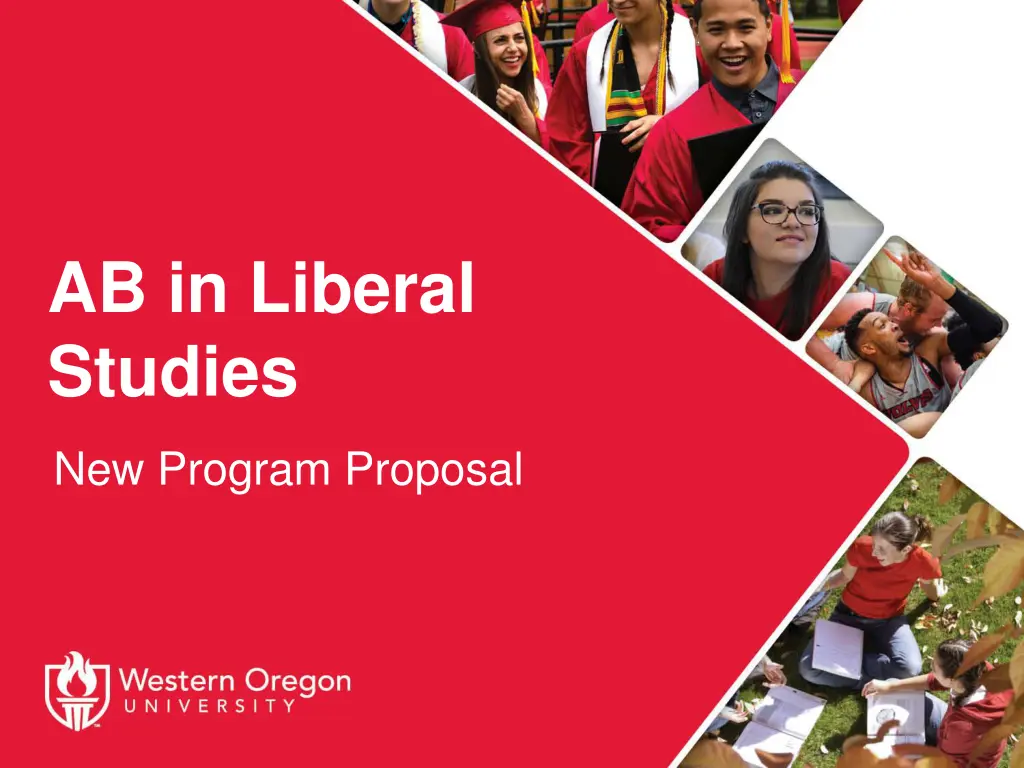
Innovative Proposal for Adult Learners in Liberal Studies Program
Empowering working adults with career-related Associate's degrees to overcome barriers and efficiently earn a 4-year Liberal Studies degree. Addressing the plateau in high school graduates, this proposal emphasizes faculty development and curriculum design principles to enhance interdisciplinary education and essential skills.
Uploaded on | 3 Views
Download Presentation

Please find below an Image/Link to download the presentation.
The content on the website is provided AS IS for your information and personal use only. It may not be sold, licensed, or shared on other websites without obtaining consent from the author. If you encounter any issues during the download, it is possible that the publisher has removed the file from their server.
You are allowed to download the files provided on this website for personal or commercial use, subject to the condition that they are used lawfully. All files are the property of their respective owners.
The content on the website is provided AS IS for your information and personal use only. It may not be sold, licensed, or shared on other websites without obtaining consent from the author.
E N D
Presentation Transcript
AB in Liberal Studies New Program Proposal
NEED: WHO and WHY? Working adults with a career-related Associate s degree A.A.S. in Health Records Management, Horticulture, Law Enforcement, Business Technology, Process Control, etc In 2015-16, almost 4000 AAS (or equivalent) degrees were granted at WOU s seven largest feeder community colleges In 2015-16, almost 500 AAS (or equivalent) degrees were awarded at Chemeketa AAS students face barriers to completion of a 4-year degree Already have a career-related specialization To earn a traditional 4-year degree, they need (lower- division) general education, a major, upper division credits In many ways, AAS degree holders start over to earn a 4- year degree
While also: US High School Graduates, 1976-2026 (Data aggregated by WICHE, Knocking on the College Door, 2016) 3.5 2025 4 2013 3 2031 3 3.0 After 20 years of rapid growth (from 1990-2010), number of high school graduates has hit a plateau nationwide. 2.5 Reported counts Knocking 2016 2.0 1976 1986 1996 2006 2016 2026
DEVELOPMENT: HOW? March 3, 2017 Faculty Retreat on Transfer An interdisciplinary faculty group All faculty invited and 21 faculty attended Both colleges and library represented, 6 academic divisions 17 tenure-track and 4 non-tenure track faculty attended
Breadth of Education Knowledge of human cultures and the physical and natural world: Through focused study in the sciences and mathematics, social sciences, histories, languages, and the arts, and by engagement with big questions, both contemporary and enduring Essential Skills Inquiry and analysis (applied critical thinking) Written communication Quantitative literacy What students need 90 credits, including 62 upper division Breadth of Education W, D, Math/CS/Q To meet WOU s ULO s Diversity-Related Skills Civic knowledge and engagement local /global Intercultural knowledge and competence Integrative and applied learning
DEVELOPMENT: HOW? The group identified principles of design for the program: Flexibility of curriculum, delivery, student services Integration of the educational experience across disciplines, AAS and WOU program, WOU experience and work lives Coherence of curricular offerings Breadth of education, and ways to build distribution requirements into the model for an upside down degree Facilitating community building among working adult students Transparency of programs and services for these students Confirming the needs of this student population and working closely with our community college partners and local employers (esp. state government)
DEVELOPMENT: HOW? Follow up Given the opportunity to respond anonymously, all participants indicated that WOU should continue to develop an upside down degree program for AAS degree holders 10 participants volunteered to continue to work on the proposal for the program Target for curriculum proposal to be submitted to the Curriculum Committee: Fall 2017 Additional investigation of need for the program (among AAS students, community colleges, employers including Oregon state government)
LEARNING OUTCOMES: WHAT? AB-LS1: Practice different and varied forms of knowledge, inquiry, and expression that frame academic and applied learning (GE1: Intellectual Foundations and Breadth) AB-LS2: Articulate the challenges, responsibilities and privileges of belonging in a complex, diverse, interconnected world (GE2: Citizenship; ULO: Diversity) AB-LS3: Demonstrate the ability to evaluate information and develop evidence-based conclusions. (GE 3: Critical Thinking; ULO: Inquiry & Analysis); AB-LS4: Integrate perspectives and strategies across disciplines to answer questions and solve problems. (GE 4: Multi-disciplinary learning; ULO: Integrative Learning); AB-LS5: Demonstrate reflection and self-assessment in completing the self-defined, multidisciplinary program of study that achieves your learning goals (Program-specific)
COMPONENTS: WHAT? UPSIDE-DOWN? DEGREE? MODEL? Western? Oregon? University? Applied? Baccalaureate? in? Liberal? Studies? ? COMPLETE? AT? WOU? Associate? of? Applied? Science? (AAS)? COMPLETE? AT? A? COMMUNITY? COLLEGE? Flexibility Coherence Community
DELIVERY: WHERE, WHEN AND HOW? Flexible delivery convenient to working adults Hybrid courses in Salem: Coherence through thematic thread(s) Sequences or clusters of existing and/or newly developed upper division courses Also existing online and on-campus courses Schedule consistency & growth - for example 2018-19: Tuesday, Thursday, 6-8 pm; 8-10 pm 2019-20: expands to include Wednesday and/or Saturday (9-11 am; 11-1 pm) 2020-21: expands to include multiple offerings in a single time slot Faculty participation AB in LS Professional Learning Community around working with adult learners and AB in LS thematic threads Hybrid course development support
GOVERNANCE, ADMINISTRATION, ASSESSMENT & CURRICULUM DEVELOPMENT: More HOW? Governance: AB in LS Advisory Board, a committee with by-laws Administration: Faculty Chair of IDS Advisory Board, reports to Provost or designee AB Courses: LS 300, 499 taught by AdBoard members; faculty developed and delivered, AdBoard approved, Salem-based disciplinary courses (including thematic clusters/sequences of courses); existing WOU offerings Advising: TBA (Faculty Chair/Coordinator, program staff) Assessment and curriculum development: AdBoard reviews and acts upon assessment data provided by AB in LS Chair and faculty assessment committee
